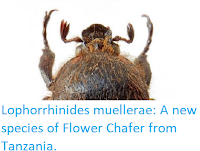Longhorn Beetles, Cerambycidae, are a widespread and diverse group,
noted for their elongated antennae, which are often longer than their
bodies (though some species lack these). Their larvae are wood-boring
grubs, which can be destructive to timber, and many species are
considered pests, both in the forestry industry and in human dwellings
as woodworm. Some of the largest species of Beetle are Longhorns,
including the 16 cm Titan Beetle (Titanus giganteus) of South America. Members of the genus Amamiclytus are Small-bodied Longhorn Beetles with black, glossy bodies and white pubescent markings on the elytra (wing cases), found across Asia including India, Sri Lanka, China, Thailand, Laos, Vietnam, and the Ryukyu Islands. There are currently nineteen described species in the genus, two of which are known from China.
In a paper published in the journal ZooKeys on 14 November 2019, Shulin Yang and Cha Wang of the School of Life Sciences at Guizhou Normal University, describe a new species of Amamiclytus from Guizhou Province, China.
The species is decribed from two male specimens collected by by net sweeping on a Flowering Bird Cherry, Prunus sp., in the village of Wuxing in Leishan County. The species is named Amamiclytus wuxingensis, meaning 'from Wuxing'. These specimens are 3.5 and 5.0 mm in length, predominantly black and glossy, with brown mouthparts, antenna, abdomen and legs. The body is sparsely covered with long pale hairs.
Amamiclytus wuxingensis, male specimen in dorsal view. Scale bar is 1 mm. Yang & Wang (2019).
See also...
Follow Sciency Thoughts on Facebook.







